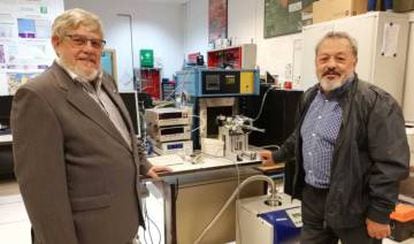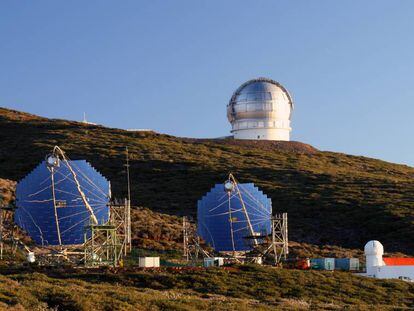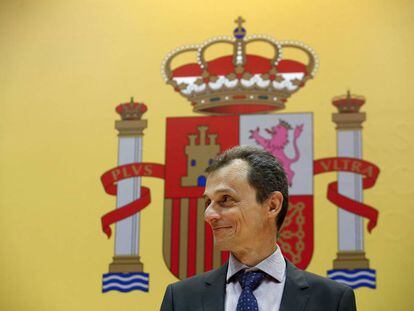How Spaniards helped the US get to the Moon
The Spanish staff at the monitoring station in Madrid were the first to listen to the astronauts as they landed in 1969

When spaceflight Apollo 11 landed on the Moon on July 20, 1969, NASA told mission commander Neil Armstrong and pilot Buzz Aldrin to take a nap.
According to Carlos González, one of the few Spaniards contracted by the US agency for the historic mission, Armstrong railed in response. “I’ve spent years preparing for this moment. After traveling 400,000 km, I’ve landed on the Moon with some difficulty, and now you’re asking me to sleep?”
We were in a privileged position because we were privy to the transmissions between Houston and Apollo 11 before anyone else
Carlos González
The US wanted the whole of America to be watching when Armstrong took the epic step. Hence the request that he should do it at a time when most Americans were likely to be in front of their TV sets. But both astronauts refused to sleep and, instead, began to take photos of the lunar landscape. Six hours later, NASA gave them permission to leave the Eagle space capsule.
González was the communications controller for the legendary Apollo 11 space flight, working out of the Fresnedillas de la Oliva monitoring station in the Madrid region alongside Spanish engineer José Manuel Grandela, who was just 23 when he joined the mission. Last week, both men were present at the Astrobiology Center to discuss the premiere of Damien Chazelle’s First Man, starring Ryan Gosling as “the reluctant American hero.”
“We were in a privileged position because we were privy to the transmissions between Houston and Apollo 11 before anyone else,” says González.

The two Spaniards were the first to hear Armstrong declare, “The Eagle has landed” when the capsule touched the Moon’s surface. According to González, “that day, Armstrong wanted to step on the Moon at all costs.”
There had been a number of critical situations that had put the mission at risk. When it was time to land, Armstrong realized that he was flying over landing points four seconds earlier than calculated, which meant touching ground around eight kilometers from the designated points. “Houston proposed aborting the mission, but Armstrong took charge of the semi-automatic controls and, with Buzz Aldrin feeding him altitude and speed data, he landed with less than 30 seconds’ worth of fuel,” explains González.
“When NASA allowed them to leave the capsule, Armstrong put on his suit, which on Earth would weigh 80 kilograms, and his survival pack,” says González. “Then, he depressurized the capsule, opened the hatch and tripped twice as he tried to get out, prompting the remark, ‘How come I have done this 300 times in the simulator and now I’m tripping?’”
González also had access to the astronauts’ vital signs, and he recalls that Armstrong’s pulse rate increased when he was having trouble leaving the capsule. When he finally managed to get out, Armstrong uttered the immortal line: “One small step for man, one giant leap for mankind.” It would take another 17 minutes for Buzz Aldrin to join him on the Moon’s surface, according to Grandela, because Aldrin had realized something that the engineers had missed in designing the capsule. “The hatch did not have a handle on the outside and, although there is no breeze up there, he spent time looking for something to wedge in the door in case it closed on them,” says Grandela.

Space Race
The mission was an important milestone for the US in its space race with the USSR. As Grandela says, “NASA had an ambitious program. It wanted to send 20 missions to the Moon and then establish something habitable there.” But just over three years later, the project was put on hold. The astronauts from Apollo 17, Eugene Cernan and Harrison Schmitt, were the last to set foot on the Moon on December 11, 1972.
It has been over 45 years since a human last set foot on the Moon. However, the trips were far from futile. “Thanks to the Apollo missions and the samples that were brought back, we have an idea of how it was formed and of the solar system’s origins – information that has been the foundation for all subsequent science,” says Miguel Hesse, director of the Astrobiology Center.
Moreover, as Grandela explains, the Moon landings between 1969 and 1972 helped generate an avalanche of inventions in the realms of engineering, computing, materials and fuel, which today benefit all of humankind.
“Now, the medium-term plan, looking at least 20 years ahead, has to be landing on Mars,” says Hesse, who adds that it would first be advisable to make another trip to the Moon. “A lunar mission is simpler and cheaper and allows new technology and survival systems to be tested before getting into a complex mission such as going to Mars.”
González explains that the spacecraft that would be used to travel to Mars would need to be intelligent so that it could self-repair or at least instruct the astronauts how to do so, without having to contact Earth.
English version by Heather Galloway.













































